CAT4 Level D [Year 7]: Free Practice Test & Sample Questions
This comprehensive guide covers everything you need to know about the CAT4 Level D test.
We’ll provide a detailed overview of the CAT4 Year 7 test format, along with sample questions, practice tests, and tips to help your child prepare effectively and score high.
Let’s get started on this journey towards CAT4 success!
What Is the CAT4 Level D Test?
The CAT4 Level D test is designed for Year 7 students (ages 10-12). It assesses critical thinking skills in areas like verbal, nonverbal, quantitative, and spatial reasoning. This test helps identify student strengths and potential for academic success.
The CAT4 was created by GL Assessment and it’s administered in a paper-based or online version and takes about two hours to complete. Results are available after 15 business days for the paper-based version or instantly for the digital version.
Get these accurate CAT4 Level D practice tests to help maximize your child’s score.
What Does the CAT4 Level D Test Consist of?
The CAT4 test for year 7 consists of four batteries, each includes two subsections:
- Non-Verbal Reasoning Battery: Figure Classification and Figure Matrices questions
- Verbal Reasoning Battery: Verbal Classification and Verbal Analogies questions
- Quantitative Reasoning Battery: Number Series and Number Analogies questions
- Spatial Reasoning Battery: Figure Analysis and Figure Recognition questions
So overall, there are 8 different subsections on the test.
The exam itself has three parts, each with its own time limits and amount of questions:
Part 1
- Figure Classification: 24 questions, 10 minutes
- Figure Matrices: 24 questions, 10 minutes
Part 2
- Verbal Classification: 24 questions, 8 minutes
- Verbal Analogies: 24 questions, 8 minutes
- Number Analogies: 18 questions, 10 minutes
Part 3
- Number Series: 18 questions, 8 minutes
- Figure Analysis: 18 questions, 9 minutes
- Figure Recognition: 18 questions, 9 minutes
Below are practice questions for each of the question types. For more practice questions in addition to the ones below, visit this excellent test prep page.
Free CAT4 Level D (Year 7) Practice Test
Non-Verbal Reasoning Practice Questions
Figure Classification Question
Choose the answer that shares the same connection/characteristic as the three given images.
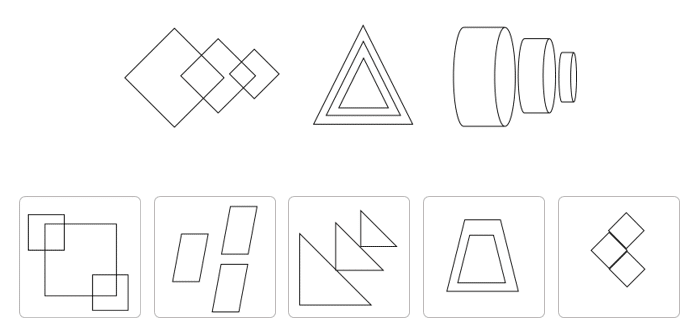
Correct Answer & Explanation:
The correct answer is the 3rd from the left.
In this question, you can see that all figures consist of identical shapes but in three different sizes.
The triangle shape in answer choice 3 is repeated three times in three different sizes. Therefore, it is the correct answer.
Answer choice 1 is incorrect because the small-sized square is repeated twice, and therefore the figure has only two sizes.
Answer choices 2 and 5 are incorrect because the shape is repeated three times in the same size.
Answer choice 4 is incorrect because it consists of only two shapes.
Figure Matrices Question #1
Choose the answer choice that follows the pattern and completes the matrix.
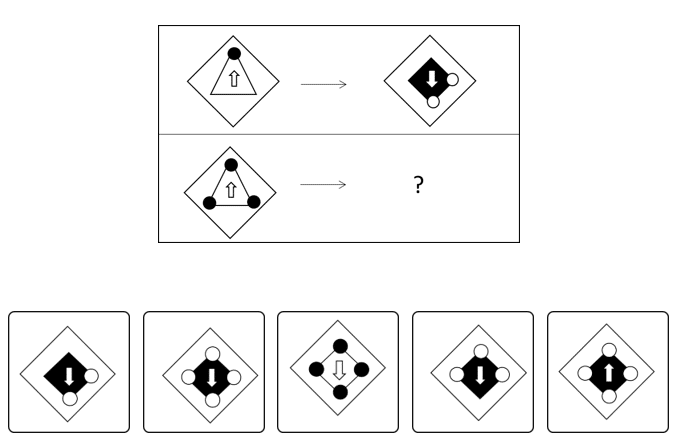
Correct Answer & Explanation:
The correct answer is the 2nd from the left.
In the top row, we have two figures – how do they go together?
As we move from left to right:
• The white triangles change into black diamonds,
• The arrows rotate 180 degrees but remain white,
• The number of circles increases by one, and –
• The circles change colors from black to white
We can eliminate answer choice 1 as it contains a white arrow but not four white circles. We can eliminate answer choice 3 as it contains a white diamond, not a black one. In addition, this answer choice contains black circles instead of white ones.
We can eliminate answer choice 4 as it contains three circles instead of four.
Finally, we can eliminate answer choice 5 as it contains an arrow that has not been rotated.
We are left with answer choice 2, which is the correct answer.
Figure Matrices Question #2
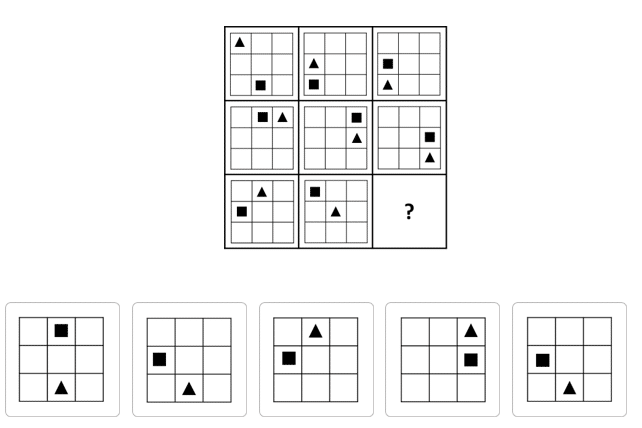
Correct Answer & Explanation:
The correct answer is the 1st from the left.
This matrix comprises nine squares divided into three rows or three columns. Each square of the matrix contains a grid of nine squares, also divided into three rows or three columns, with a square and a triangle in each one.
To avoid confusion, we will refer to the greater division of squares as the matrix and the smaller ones in each square as grids.
The square and triangle appear in different squares in the grid for each matrix square. To find the answer, we can track their movement across the rows of the matrix.
Across the matrix rows from the left square to the right, the square moves in a clockwise direction along the outer boundary of the grid and moves one spot to the right in the grid with each step. The triangle remains in the same column of the grid and moves one spot down in the grid with each step.
Therefore, following the rows, the position of the square in the bottom left square of the matrix should be the top-middle square of the grid, and the position of the triangle should be the bottom-middle square of the grid.
Only the 1st answer choice matches this description, so it is the correct answer.
Verbal Reasoning Practice Questions
Verbal Analogy Question #1
The first pair of words go together in a certain way. Choose the word that goes together with the third word in the same way.
interrogate → question : declare →
A. speak
B. state
C. yell
D. command
E. voice
Correct Answer & Explanation:
The correct answer is (B) – state. If someone interrogates someone, they question them. If someone declares something, they state it. In this case, the first verb is clarified or better explained by the second verb.
Verbal Analogy Question #2
bricks → building : bulldozer →
A. hauling
B. trashing
C. destroying
D. constructing
E. site
Correct Answer & Explanation:
The correct answer is (C) – destroying. Bricks are used for building. A bulldozer is used for destroying. In this case the first word (a noun) is paired with what action it represents (the second word).
Verbal Classification Question
Choose the word that belongs in the same group as the first three words.
parallel | diagonal | horizontal
A. geometry
B. lines
C. symmetry
D. math
E. perpendicular
Correct Answer & Explanation:
The correct answer is (E) – perpendicular.
Parallel, diagonal, horizontal, and perpendicular are all types of lines. These words are paired because of their relationship to geometry and math.
Want to help your child feel more prepared? This CAT4 Level D course builds confidence through targeted practice and clear explanations.
Quantitative Reasoning Practice Questions
Number Analogy Question
Choose the number that completes the third pair so that it demonstrates the same relationship as the first two pairs.
[30 → 195] [40 → 255] [15 → ?]
A. 200
B. 90
C. 105
D. 300
E. 140
Correct Answer & Explanation:
The correct answer is (C) – 105.
In the first pair, the number 30 is transformed into 195. The answer is obtained by multiplying it by 6 and then adding 15 to the answer (30 * 6 = 180 + 15 = 105).
In the second pair, the number 40 is transformed into 255. Again, the relationship is multiplying by 6 (40 * 6 = 240+15 = 255).
You can notice that the number on the right is obtained by multiplying the number on the left by 6 and then adding 15.
Let’s apply the same pattern to the third number pair, [15 → If we multiply 15 by 6 and then add 15, we get 15 * 6 = 90+15 = 105.
Number Series Question #1
What number comes next in the series?
53 66 78 89 99 108 ?
A. 109
B. 113
C. 107
D. 112
E. 116
Correct Answer & Explanation:
The correct answer is (E) – 116.
In the series, the next number is obtained by adding 13 to the previous number in the first turn, then adding 12 to the previous number in the second turn, and so on. The number added to get the next number decreases by 1 with each turn. The sequence is 53+13=66, 66+12=78, 78+11=89, 89+ 10 = 99, 99 + 9 = 108 and 108 + 8 = 116.
Number Series Question #2
4 3 4 4 4 5 4 6 4 ?
A. 10
B. 8
C. 7
D. -9
E. -6
Correct Answer & Explanation:
The correct answer is (C) – 7.
In the series, the numbers at odd positions remain the same, and the numbers at even positions increase by 1 while moving toward the right. The sequence is 4, 3, 4, 3+1=4, 4, 4+1=5, 4, 5+1=6, 4, 6+1= 7.
Spatial Ability Practice Questions
Figure Analysis Question #1
Choose the answer choice that shows the final product of the unfolded punched-in paper.
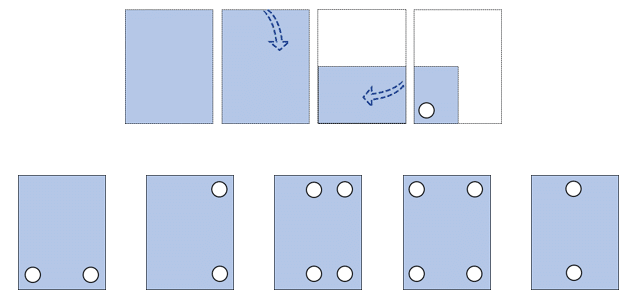
Correct Answer & Explanation:
The correct answer is the 4th from the left.
A4 paper is folded into a half rectangle and then into a quarter rectangle. When the hole is punched into it, it will punch the four sides of the paper. We can observe that all corners of the paper are folded towards this corner where the hole has been punched, so it will have four holes at its corners when the paper is unfolded.
Figure Analysis Question #2
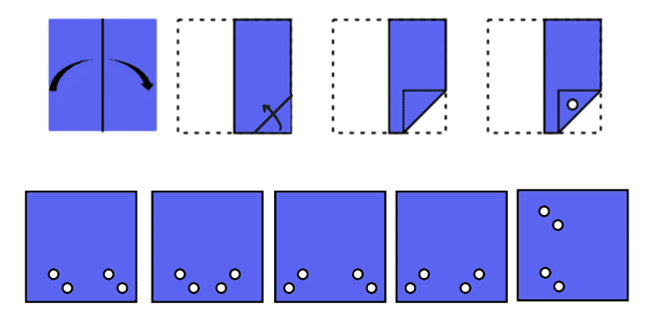
Correct Answer & Explanation:
The correct answer is the 3rd from the left.

Figure Recognition Question
Choose the answer choice that contains the given shape. The shape must keep its size and orientation.
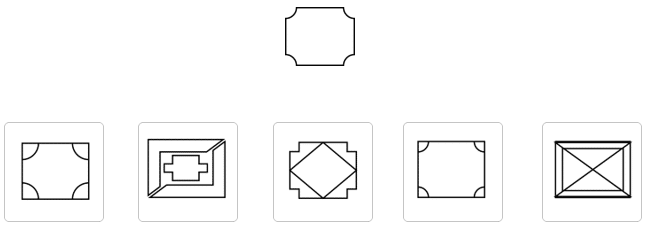
Correct Answer & Explanation:
The correct answer is the 4th from the left.
The shape is visible in the middle of option 4.
Give Your Child an Edge on the CAT4 Level D with These Helpful Resources
Finding the right resources is crucial when preparing for the CAT4 Level D. While schools have their limitations, the right external support can make a huge difference. After carefully evaluating different options, we highly recommend TestPrep-Online. Here’s why:
- Realistic Practice: 18 comprehensive tests that closely match the actual CAT4 format.
- Detailed Explanations: Help students understand their mistakes and learn from them
- Organized Study Guides: Provide structured knowledge and reinforcement
Build Confidence & Skills: Get 18 accurate CAT4 Level D practice tests for effective prep.
Understanding Your Child’s CAT4 Level D Results
Your child’s results on the CAT4 Level D will include several scores. Here’s a breakdown of what they mean:
- Raw Score: This is simply the number of questions your child answered correctly on the test. It’s a useful starting point, but doesn’t tell the whole story.
- Key Scores:
- Standard Age Score (SAS): This is the most important score as it compares your child directly to others in their age group. The average SAS is set at 100. A score above 100 shows above-average performance, while below 100 indicates areas for improvement.
- National Percentile Rank (NPR): The NPR helps visualize how your child’s score compares to the national average. For example, an NPR of 85 means they scored higher than 85% of students in their age group.
- Stanines (ST): Stanines provide a broader picture. They place scores in nine bands, where 1 is the lowest and 9 is the highest. Stanines help give a general sense of your child’s overall performance.
Remember: A high SAS means your child is performing well compared to their peers, even if students from different age groups have the same SAS.
What Is a Good Score on the CAT4 Year 7 Test?
A good score on the CAT4 Year 7 test can vary depending on the individual student’s age and other factors. However, the average CAT4 score is 100, so scoring above the 100 average (in Stanines 7-9) is generally considered a good score.
13 Actionable Tips for CAT4 Year 7 Test Success
- Start with a Baseline: A quick practice test (like the one on this page) reveals strengths and weaknesses. This helps avoid wasting time on areas your child already excels in.
- Targeted Practice: Once you know the weak spots, get resources addressing those specific question types. This makes prep more efficient.
- Explain Wrong Answers: Simply knowing the right answer doesn’t always prevent future mistakes. Help your child break down the question to see where their thinking went wrong.
- Timed Practice Sessions: Help your child get used to the test’s time constraints. Start with short practice sessions and gradually increase the time.
- Vocabulary Jar: Every time they stumble across an unfamiliar word, they write it down. Look up the definitions together and practice using them in sentences.
- “Why?” Questions: Stimulate critical thinking by asking “why?” about everyday phenomena. Guide them towards figuring out the explanation on their own.
- Math Games: Make math practice enjoyable and engaging! Check out apps like Prodigy Math Game or DragonBox games that cleverly disguise learning as play.
- Confidence Corner: A designated “achievement wall” visualizes progress. Pin up certificates, great practice scores, or even their own drawings celebrating their hard work.
- Teacher Collaboration: Your child’s teacher might have insights into areas where they struggle during regular classroom activities. You can focus your home practice on these areas.
- Brain Breaks: Active breaks boost focus and energy levels. Suggest a quick dance-off to their favorite song or 10 minutes of jumping rope outside.
- Tech Time-Outs: Blue light from screens disrupts sleep, which impacts concentration. Enforce a no-screen rule for at least an hour before bedtime.
- Mistake Analysis: Analyze incorrect answers from practice tests together. Can they find and solve a similar question successfully now?
- Focus on the Positive: Celebrate their dedication and hard work, not just the scores on tests. Building intrinsic motivation is key for long-term learning.
Conclusion and Additional CAT4 Guides
The CAT4 Level D (Year 7) test is a key assessment tool for measuring cognitive abilities in various areas. Familiarizing your child with the test structure, content, and format through practice tests and drills can help them gain the confidence and skills needed to perform well.
Additionally, using other preparation techniques such as developing a study plan, analyzing practice test results, and focusing on your child’s weaknesses can greatly improve their performance on the test.
With the help of the resources provided in this article, you can help your child achieve success on the CAT4 Level D (Year 7) test and set them up for future academic achievements.
More CAT4 Test Guides on Our Site:
- 18 Accurate CAT4 Level D Practice Tests
- CAT4 Free Practice Test
- CAT4 Level X [Year 2]
- CAT4 Level A [Year 4]
- CAT4 Level B [Year 5]
- CAT4 Level C [Year 6]
- CAT4 Level E [Year 8]
- CAT4 Level F [Year 9 & Year 10]
- CAT4 Level G [Year 11+]
- How to Prepare for the CAT4 Test
- CAT4 Test Results Explained
- CAT4 Age Levels Explained
